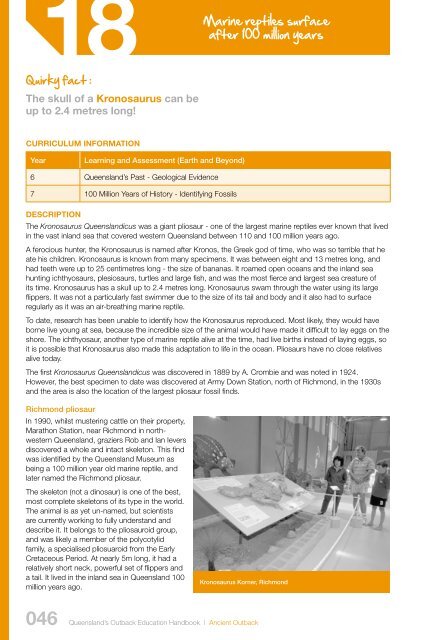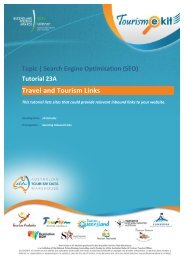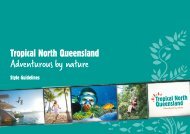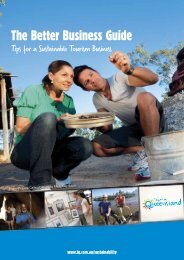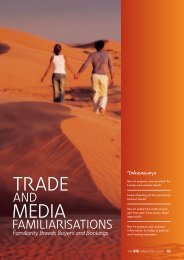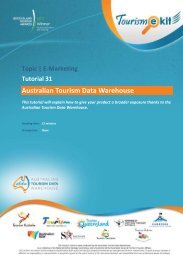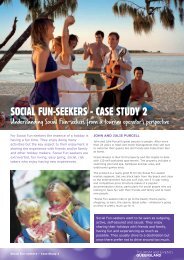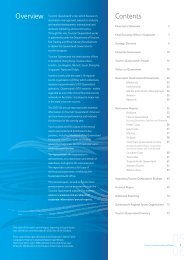Outback Education Handbook PDF - Tourism Queensland
Outback Education Handbook PDF - Tourism Queensland
Outback Education Handbook PDF - Tourism Queensland
You also want an ePaper? Increase the reach of your titles
YUMPU automatically turns print PDFs into web optimized ePapers that Google loves.
18<br />
Marine reptiles surface<br />
after 100 million years<br />
Quirky fact :<br />
The skull of a Kronosaurus can be<br />
up to 2.4 metres long!<br />
Curriculum Information<br />
Year<br />
Learning and Assessment (Earth and Beyond)<br />
6 <strong>Queensland</strong>’s Past - Geological Evidence<br />
7 100 Million Years of History - Identifying Fossils<br />
Description<br />
The Kronosaurus <strong>Queensland</strong>icus was a giant pliosaur - one of the largest marine reptiles ever known that lived<br />
in the vast inland sea that covered western <strong>Queensland</strong> between 110 and 100 million years ago.<br />
A ferocious hunter, the Kronosaurus is named after Kronos, the Greek god of time, who was so terrible that he<br />
ate his children. Kronosaurus is known from many specimens. It was between eight and 13 metres long, and<br />
had teeth were up to 25 centimetres long - the size of bananas. It roamed open oceans and the inland sea<br />
hunting ichthyosaurs, plesiosaurs, turtles and large fish, and was the most fierce and largest sea creature of<br />
its time. Kronosaurus has a skull up to 2.4 metres long. Kronosaurus swam through the water using its large<br />
flippers. It was not a particularly fast swimmer due to the size of its tail and body and it also had to surface<br />
regularly as it was an air-breathing marine reptile.<br />
To date, research has been unable to identify how the Kronosaurus reproduced. Most likely, they would have<br />
borne live young at sea, because the incredible size of the animal would have made it difficult to lay eggs on the<br />
shore. The ichthyosaur, another type of marine reptile alive at the time, had live births instead of laying eggs, so<br />
it is possible that Kronosaurus also made this adaptation to life in the ocean. Pliosaurs have no close relatives<br />
alive today.<br />
The first Kronosaurus <strong>Queensland</strong>icus was discovered in 1889 by A. Crombie and was noted in 1924.<br />
However, the best specimen to date was discovered at Army Down Station, north of Richmond, in the 1930s<br />
and the area is also the location of the largest pliosaur fossil finds.<br />
Richmond pliosaur<br />
In 1990, whilst mustering cattle on their property,<br />
Marathon Station, near Richmond in northwestern<br />
<strong>Queensland</strong>, graziers Rob and Ian Ievers<br />
discovered a whole and intact skeleton. This find<br />
was identified by the <strong>Queensland</strong> Museum as<br />
being a 100 million year old marine reptile, and<br />
later named the Richmond pliosaur.<br />
The skeleton (not a dinosaur) is one of the best,<br />
most complete skeletons of its type in the world.<br />
The animal is as yet un-named, but scientists<br />
are currently working to fully understand and<br />
describe it. It belongs to the pliosauroid group,<br />
and was likely a member of the polycotylid<br />
family, a specialised pliosuaroid from the Early<br />
Cretaceous Period. At nearly 5m long, it had a<br />
relatively short neck, powerful set of flippers and<br />
a tail. It lived in the inland sea in <strong>Queensland</strong> 100<br />
million years ago.<br />
Kronosaurus Korner, Richmond<br />
046<br />
<strong>Queensland</strong>’s <strong>Outback</strong> <strong>Education</strong> <strong>Handbook</strong> | Ancient <strong>Outback</strong>


